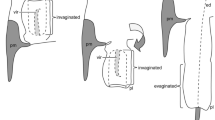Abstract
IN 1927, Watson1 described the construction of a number of glass microsyringes which he had used for the instrumental insemination of queen honey-bees. The tips of these syringes were straight and the operator holds one of these syringes in line with the long axis of the queen when, introducing it into her vagina. This type of glass syringe was simplified and improved during the course of time both by Watson himself and also by Nolan2 and others; but really satisfactory results were infrequently obtained at this stage.
This is a preview of subscription content, access via your institution
Access options
Subscribe to this journal
Receive 51 print issues and online access
$199.00 per year
only $3.90 per issue
Buy this article
- Purchase on Springer Link
- Instant access to full article PDF
Prices may be subject to local taxes which are calculated during checkout
Similar content being viewed by others
References
Watson, L. R., “Controlled Mating of Queenbees” (Hamilton, Ill., 1927).
Nolan, W. J., “Bee Breeding”, U.S.D.A. Yearbook Separate No. 1604 (1937).
Laidlaw, H. H., J. Morph., 74, 429 (1944).
Mackensen, O., and Roberts, W. C., “A Manual for the Artificial Insemination of Queenbees”, U.S.D.A. Bur. Ent. and Plant Quar. ET-250 (1948).
Roberts, W. C., J. Econ. Ent., 40, 445 (1947).
Author information
Authors and Affiliations
Rights and permissions
About this article
Cite this article
BUTLER, C. A New Design of Microsyringe Tip for the Instrumental Insemination of Queen Honey-bees. Nature 166, 957–958 (1950). https://doi.org/10.1038/166957a0
Issue Date:
DOI: https://doi.org/10.1038/166957a0
Comments
By submitting a comment you agree to abide by our Terms and Community Guidelines. If you find something abusive or that does not comply with our terms or guidelines please flag it as inappropriate.



